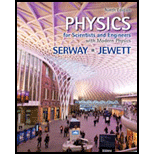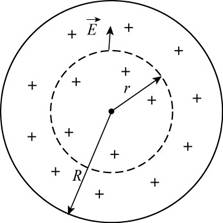
Concept explainers
A solid sphere of radius 40.0 cm has a total positive charge of 26.0 μC uniformly distributed throughout its volume. Calculate the magnitude of the electric field (a) 0 cm, (b) 10.0 cm, (c) 40.0 cm, and (d) 60.0 cm from the center of the sphere.
(a)
The electric field at
Answer to Problem 35P
The electric field at
Explanation of Solution
Given info: The radius of solid sphere is
The diagram for the given condition is shown below.

Figure (1)
The charge enclosed by the Gaussian surface is,
Here,
The area of the sphere is,
The Gauss law is,
Here,
Substitute
Here,
Substitute
Conclusion:
Therefore, the electric field at
(b)
The electric field at
Answer to Problem 35P
The electric field at
Explanation of Solution
Given info: The radius of solid sphere is
Recall the equation (1).
Substitute
Conclusion:
Therefore, the electric field at
(c)
The electric field at
Answer to Problem 35P
The electric field at
Explanation of Solution
Given info: The radius of solid sphere is
Recall the equation (1).
Substitute
Conclusion:
Therefore, the electric field at
(d)
The electric field at
Answer to Problem 35P
The electric field at
Explanation of Solution
Given info: The radius of solid sphere is
The distance
Then,
Substitute
Conclusion:
Therefore, the electric field at
Want to see more full solutions like this?
Chapter 24 Solutions
Physics for Scientists and Engineers With Modern Physics
Additional Science Textbook Solutions
Cosmic Perspective Fundamentals
Human Biology: Concepts and Current Issues (8th Edition)
Fundamentals Of Thermodynamics
Chemistry: Atoms First
Campbell Biology (11th Edition)
- Help me make a visualize experimental setup using a word document. For the theory below.arrow_forwardHow to solve this, given answerarrow_forwardThree point-like charges are placed at the corners of a square as shown in the figure, 28.0 cm on each side. Find the minimum amount of work required by an external force to move the charge q1 to infinity. Let q1=-2.10 μC, q2=+2.40 μС, q3=+3.60 μC.arrow_forward
- A point charge of -4.00 nC is at the origin, and a second point charge of 6.00 nC is on the x axis at x= 0.820 mm . Find the magnitude and direction of the electric field at each of the following points on the x axis. x2 = 19.0 cmarrow_forwardFour point-like charges are placed as shown in the figure, three of them are at the corners and one at the center of a square, 36.0 cm on each side. What is the electric potential at the empty corner? Let q1=q3=+26.0 µС, q2=-28.0 μC, and q4=-48.0μc Varrow_forwardPLS HELparrow_forward
 Principles of Physics: A Calculus-Based TextPhysicsISBN:9781133104261Author:Raymond A. Serway, John W. JewettPublisher:Cengage Learning
Principles of Physics: A Calculus-Based TextPhysicsISBN:9781133104261Author:Raymond A. Serway, John W. JewettPublisher:Cengage Learning
 Physics for Scientists and Engineers: Foundations...PhysicsISBN:9781133939146Author:Katz, Debora M.Publisher:Cengage Learning
Physics for Scientists and Engineers: Foundations...PhysicsISBN:9781133939146Author:Katz, Debora M.Publisher:Cengage Learning Physics for Scientists and Engineers with Modern ...PhysicsISBN:9781337553292Author:Raymond A. Serway, John W. JewettPublisher:Cengage Learning
Physics for Scientists and Engineers with Modern ...PhysicsISBN:9781337553292Author:Raymond A. Serway, John W. JewettPublisher:Cengage Learning Physics for Scientists and EngineersPhysicsISBN:9781337553278Author:Raymond A. Serway, John W. JewettPublisher:Cengage Learning
Physics for Scientists and EngineersPhysicsISBN:9781337553278Author:Raymond A. Serway, John W. JewettPublisher:Cengage Learning Physics for Scientists and Engineers, Technology ...PhysicsISBN:9781305116399Author:Raymond A. Serway, John W. JewettPublisher:Cengage Learning
Physics for Scientists and Engineers, Technology ...PhysicsISBN:9781305116399Author:Raymond A. Serway, John W. JewettPublisher:Cengage Learning





